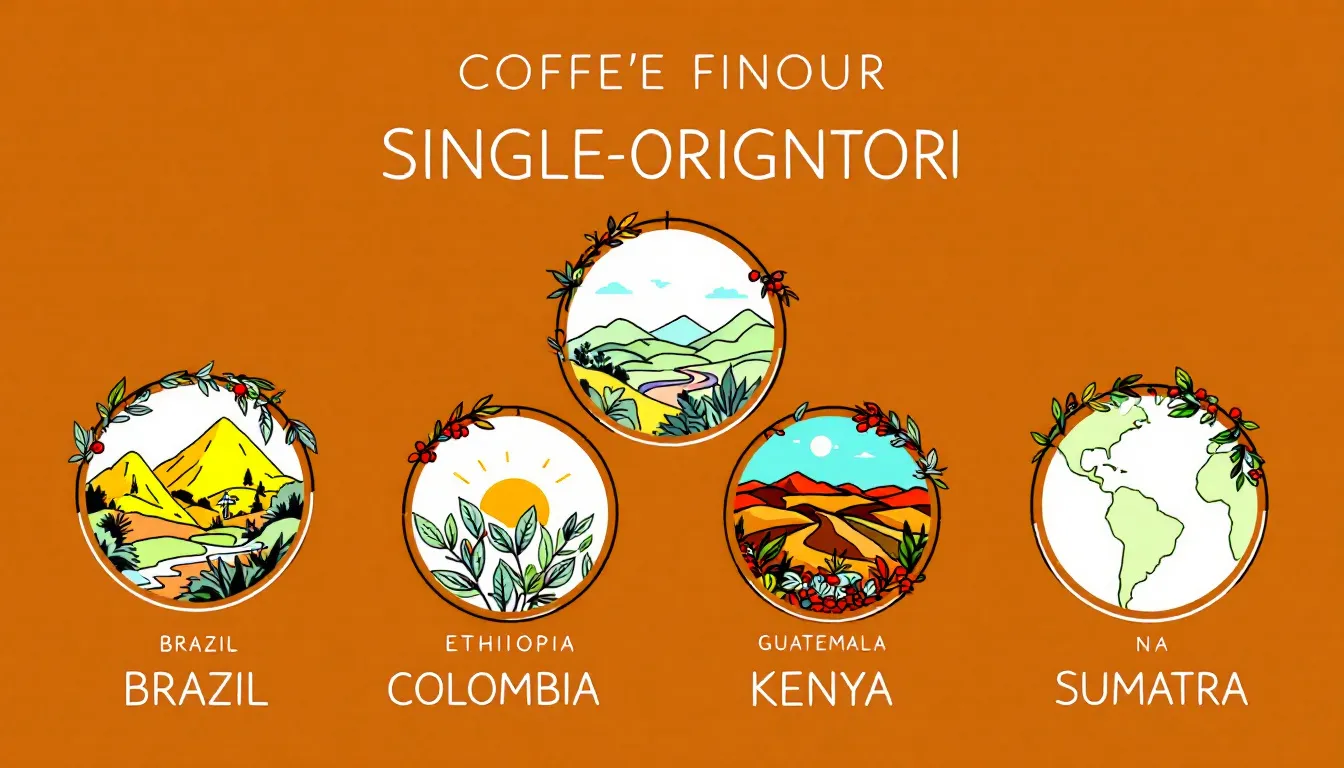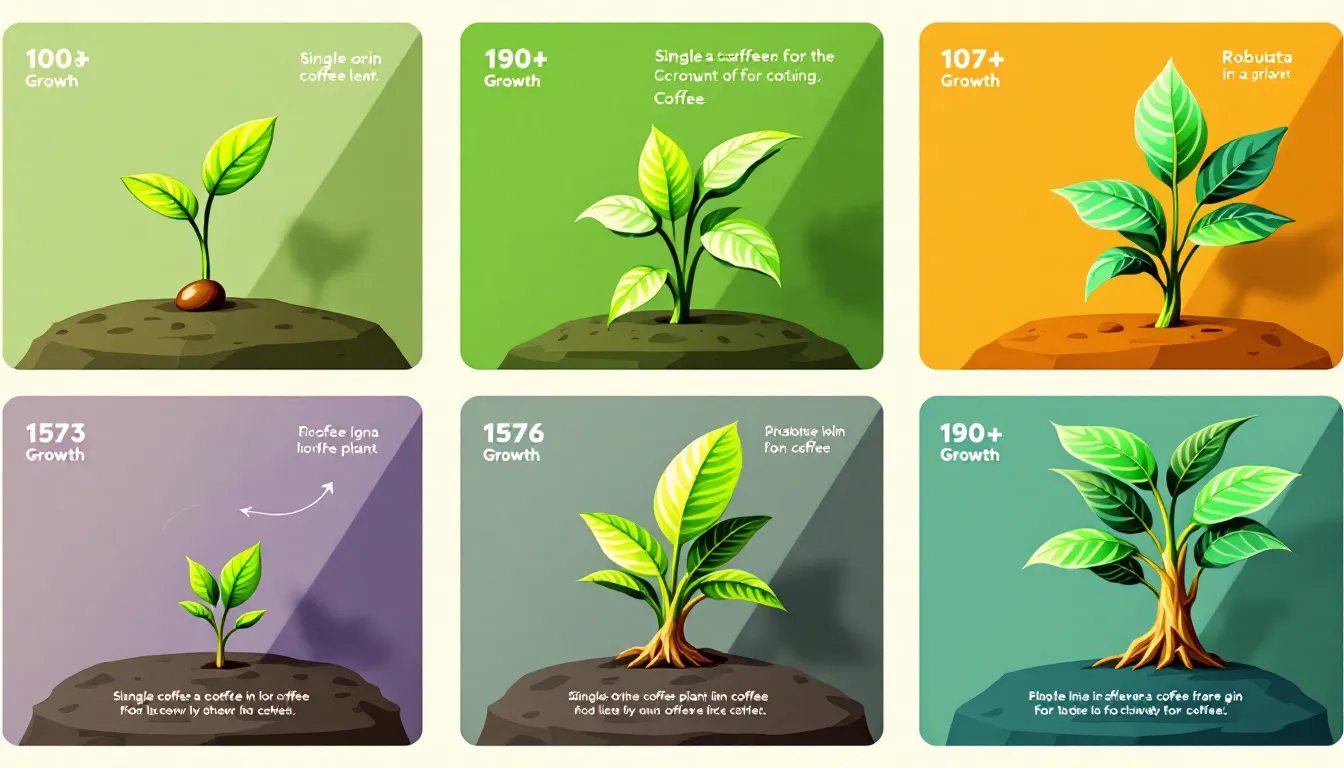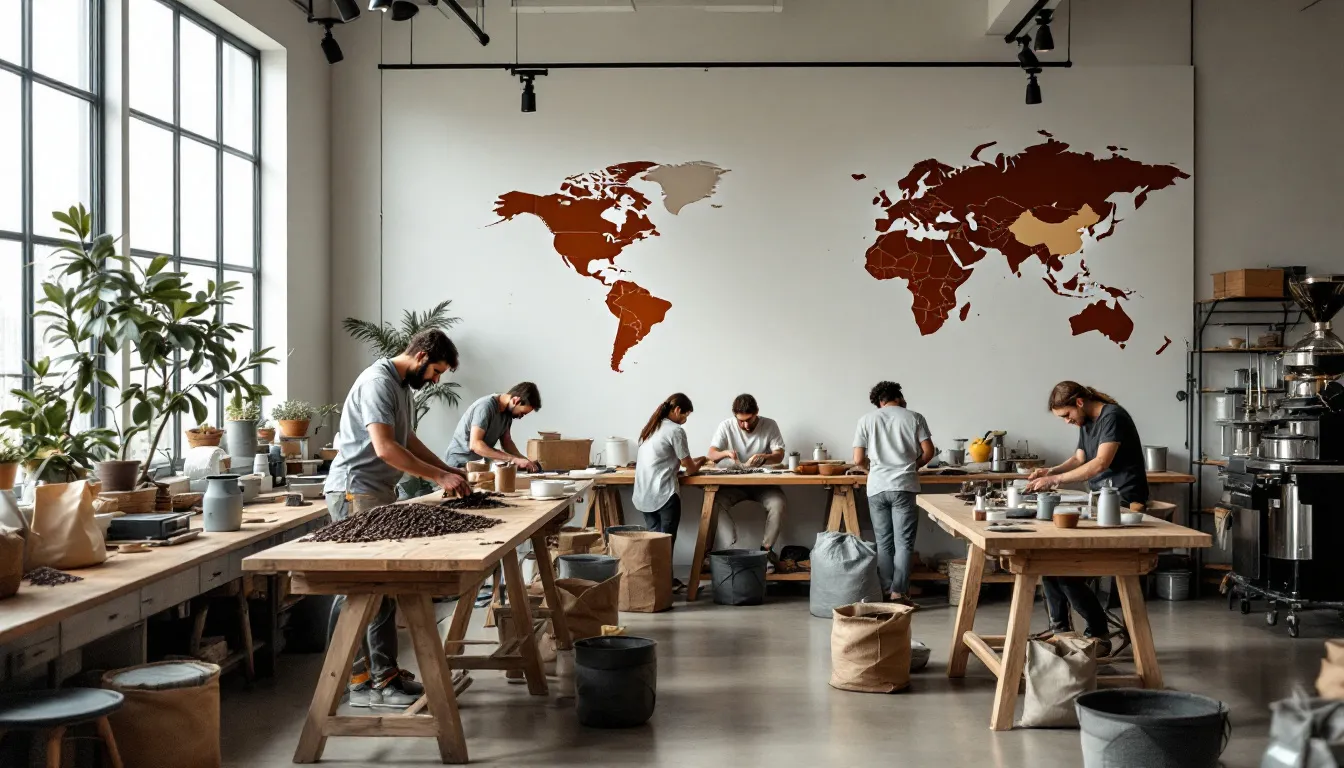Where Does Coffee Come From?
Where Does Coffee Come From?
Single origin coffee is sourced from one specific place, such as a single farm or region, and highlights the unique characteristics of the coffee bean from that area. This sets it apart from blends, which combine beans from multiple sources. The appeal of single origin coffee lies in its ability to highlight the unique flavors and characteristics of that particular place, offering a direct connection to the origins of the coffee.
Introduction to Single Origin Coffee
Single origin coffee refers to coffee beans that are sourced from a single region, farm, or producer. This type of coffee is celebrated for its unique and distinct flavor profile, which is shaped by the specific growing conditions and processing methods used. Unlike blended coffees, single origin coffees offer a purer representation of their origin, allowing coffee enthusiasts to experience the true essence of a particular locale.
The flavor profile of single origin coffee can vary greatly depending on factors such as the coffee plant variety, soil quality, and climate. For instance, coffee grown in rich volcanic soil may exhibit robust, full-bodied flavors, while beans from high elevations might have more vibrant acidity and complex flavors. These nuanced and subtle flavors often include notes of fruit, chocolate, and spices, making each cup a unique tasting experience.
Producing single origin coffee is often more labor-intensive and expensive compared to blended coffees. The meticulous care required in cultivating, harvesting, and processing these beans ensures a higher quality coffee that is highly sought after by connoisseurs.
Coffee History and Origins
Coffee has a rich and fascinating history that spans over 1,000 years, with its origins dating back to the Ethiopian plateau. According to legend, coffee was discovered by a goat herder named Kaldi, who noticed that his goats became more energetic after eating the red berries of a certain plant. Intrigued by this phenomenon, Kaldi shared his discovery with local monks, who began to use the berries to stay awake during long hours of prayer.
Coffee was introduced to Europe by European travelers, who brought back coffee beans and established coffee houses in major cities such as Venice and London. The Dutch East India Company played a significant role in the spread of coffee, establishing coffee plantations in colonies such as Indonesia and Brazil. This expansion helped coffee become one of the world’s most traded commodities.
How are Single Origin Coffees Grown?
When you drink coffee made from single origin beans, you’re not just enjoying a beverage; you’re tasting coffee history. Each cup tells a story of the coffee plants and coffee trees that thrived under certain environmental conditions, cared for by dedicated coffee producers. This traceability connects you directly to the coffee plantations and the people who nurtured the coffee plants through to harvest.
The cultivation of coffee in a specific locale means that the coffee is grown under unique conditions that influence its flavor. Factors like soil composition, altitude, and climate all play crucial roles in shaping the taste of the coffee beans. For example, coffee grown at higher elevations tends to have more vibrant acidity and complex flavors, making each cup of single origin coffee a unique tasting experience.
Single origin coffee also highlights the diversity within the world’s coffee industry. From the Ethiopian plateau to the mountains of Colombia, arabica coffee cultivated in different regions offers a wide range of flavors and aromas, showcasing various coffee varieties. This diversity is a testament to the rich coffee culture and the meticulous efforts of coffee producers who strive to deliver quality coffee produced with every harvest.
The Importance of Traceability in Single Origin Coffee
Traceability in single origin coffee ensures that customers know the exact source of their beans, fostering trust and accountability within the supply chain. This transparency is crucial in today’s coffee industry, where consumers are increasingly interested in the origins of their food and drinks. Tracing single origin coffee to specific farms or producers allows coffee drinkers to make informed choices about their coffee.
Emphasizing supply chain transparency lets consumers trace their coffee back to specific farms or producers. This connection deepens the understanding of the coffee’s journey from tree to cup, enhancing coffee culture. Consumers gain an appreciation for the meticulous care involved in every stage of coffee production, from planting seeds to harvesting ripe beans. Traceability also ensures that the coffee meets industry standards for commercial production, maintaining both quality and sustainability.
Relationships between consumers and small farms improve transparency about farming practices and environmental impacts. Knowing the source of your coffee allows support for producers who prioritize sustainability and ethical labor practices. This benefits the environment and ensures fair treatment for the people behind your coffee, allowing sustainable growth.
Traceability goes beyond knowing the origin; it encompasses accountability and quality. Tracing coffee back to its source instills confidence in its quality and authenticity. This assurance is vital for those seeking quality coffees, ensuring every cup is a product of ethical and sustainable practices.
Unique Flavor Profiles of Single Origin Coffees

Climate and specific processing methods used by the producer influence single origin coffee’s flavor. These factors create unique taste profiles that vary significantly between regions. For example, beans cultivated at higher elevations exhibit more vibrant higher acidity and intricate flavors, making each sip an exploration.
Soil composition plays a crucial role in determining the body and depth of coffee flavors. Rich soil from volcanic regions can impart a robust, full-bodied flavor, while other soils might enhance fruitiness or floral notes. This variability ensures each single origin coffee offers a distinct and memorable experience.
Processing methods like natural and washed significantly influence single origin coffee’s taste characteristics. Natural processing, drying beans with the fruit still attached, often results in fruitier, more complex flavors. Washed processing, where the fruit is removed before drying, tends to produce cleaner, brighter profiles. These methods highlight the versatility and richness of single origin coffees. Traditional preparation methods, such as brewing with hot water, can further enhance the unique flavors of single origin coffee.
Single origin coffees are often seasonal and have limited availability, produced in smaller quantities compared to blends. This rarity enhances their appeal to coffee aficionados. Limited production means each batch of single origin coffee captures a unique snapshot of its origin.
Regions Known for Single Origin Coffee

Ethiopian coffee is known for its floral and fruity profiles, often enhanced by natural processing methods imparting berry-like characteristics. This region is celebrated for varied, rich flavors, often exhibiting fruity, floral, and wine-like notes. Coffee grown here testifies to Ethiopia’s rich coffee history and its significant role in global coffee culture.
Colombian coffee typically offers a balanced profile with nutty and caramel undertones, shaped by diverse mountainous climates. Recognized for its smooth, balanced flavor, it often highlights nutty and chocolatey undertones. Colombia’s unique microclimates contribute to this diversity, making it a favorite among coffee lovers.
The coffee belt, including these regions, is where the world’s best coffee is grown. Located between the Tropics of Cancer and Capricorn, this area provides ideal conditions for coffee plants to thrive. The combination of high elevation, climate, and soil creates the ideal environment for producing high-quality beans.
Latin American countries, with their rich soil and favorable climates, are also renowned for producing high-quality single origin coffees. Exploring single origin coffees reveals one of the world’s flavors and aromas reflecting each locale’s unique conditions. This journey through the coffee belt testifies to the dedication and expertise of producers cultivating these exceptional beans.
How Single Origin Coffee is Grown

Factors like rainfall and temperature directly affect the coffee beans’ maturation process. These factors influence the growth and development of coffee plants, determining the beans’ quality and flavor.
Sustainable practices like organic farming and shade-grown techniques maintain ecological balance in cultivation. These practices protect the environment and ensure coffee plantations’ long-term viability. Using sustainable methods, producers grow coffee benefiting both the environment and local communities.
The journey of single origin coffee begins with planting coffee seeds, which are carefully selected to ensure the best quality. Cultivating single origin coffee involves balancing environmental factors and farming practices. From planting coffee seedlings to harvesting ripe cherries, every step is crucial for high-quality coffee production. Focusing on each region’s unique conditions allows producers to create beans with distinctive flavors and aromas.
Ultimately, single origin coffee cultivation aims to produce beans reflecting their origin’s unique characteristics. Understanding the specific conditions and practices in growing coffee helps consumers appreciate single origin coffees’ complexity and richness.
Coffee Culture and Consumption
Coffee culture is a significant part of many societies around the world, with coffee playing a central role in social and cultural rituals. In many countries, coffee is an important part of daily life, with people gathering in coffee houses to socialize and conduct business. The tradition of drinking coffee dates back to the Middle East, where coffee was served in coffee houses and was an important part of the social scene.
In Europe, coffee houses became popular in the 17th and 18th centuries, and were often associated with intellectual and artistic circles. These establishments were places where writers, artists, and thinkers gathered to exchange ideas and enjoy a cup of coffee. The rise of coffee houses in Europe helped to spread coffee culture and establish coffee as a popular beverage.
Today, coffee culture is a global phenomenon, with coffee shops and cafes found in almost every city and town. The rise of specialty coffee has also led to a greater appreciation for high-quality, unique, and exotic coffees. Coffee consumption is influenced by factors such as climate, culture, and economy, with different regions and countries having their own unique coffee traditions.
Whether it’s a quick espresso on the go or a leisurely cup of coffee in a cafe, coffee is an integral part of many people’s daily lives. The global coffee culture continues to evolve, with new trends and innovations constantly emerging. From the traditional coffee houses of the Middle East to the modern specialty coffee shops, coffee remains a beloved and essential part of our social and cultural fabric.
The Role of Coffee Producers in Single Origin Coffee

Local farmers and cooperatives preserve the distinct quality and authenticity of single origin coffee on one farm, where each bean reflects its origin’s conditions. These producers maintain their coffee’s unique characteristics, ensuring each batch reflects its origin’s conditions.
Purchasing single origin coffee supports small-scale farmers prioritizing quality over mass production. Choosing single origin coffee helps sustain local economies and encourages sustainable farming practices. This support is crucial for maintaining the diversity and richness of the coffee industry. For example, Brazil, as the largest producer of coffee, plays a crucial role in the global coffee market.
Single origin coffee allows farmers to receive fair compensation by eliminating intermediaries, supporting local economies. Buying directly from producers ensures those behind your coffee are fairly compensated for their hard work. This relationship benefits both farmers and consumers, creating a more sustainable and ethical coffee trade.
Supporting single origin producers can lead to better financial stability for farmers, encouraging sustainable practices. Investing in single origin coffee helps create a more sustainable and equitable industry. This support is essential for maintaining single origin coffees’ quality and authenticity.
Ultimately, producers play a crucial part in preserving the unique characteristics and quality of single origin beans. Supporting these producers helps sustain coffee culture and ensures future generations can enjoy high-quality single origin coffees in the next century.
Frequently Asked Questions
What is single origin coffee?
Single origin coffee comes from a specific region, farm, or producer, giving you a chance to savor its unique flavors and traits. It’s all about knowing where your coffee comes from!
The concept of single origin coffee gained popularity in the New World, where coffee cultivation and consumption became integral to the culture.
Why is traceability important in single origin coffee?
Traceability is essential in single origin coffee because it allows customers to know exactly where their beans come from, building trust and accountability in the process. It connects you to the farmers and the quality of their practices, enhancing your coffee experience.
Traceability also allows us to connect with the first person stories of those who have contributed to the rich history of coffee.
What factors influence the flavor of single origin coffee?
The flavor of single origin coffee is shaped by the climate, soil composition, elevation, and how the beans are processed. So, the place it comes from really matters!
The specific variety of the coffee tree also plays a crucial role in determining the flavor profile of single origin coffee.
Which regions are known for producing exceptional single origin coffee?
Ethiopia, Colombia, and Peru are some of the best places to find exceptional single origin coffee, each offering distinct flavors that reflect their unique growing conditions. If you’re looking for something special, those regions are definitely worth exploring!
How does supporting single origin coffee producers benefit local economies?
Supporting single origin coffee producers boosts local economies by providing fair compensation to small-scale farmers and promoting sustainable farming practices. This not only helps communities thrive but also ensures better quality coffee for consumers.
Historical anecdotes, such as the story of the French Governor's wife who helped smuggle coffee seeds to Brazil, highlight the fascinating history behind coffee trade and production.
